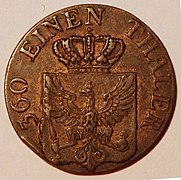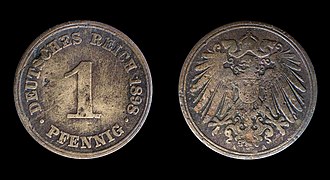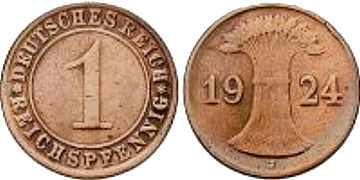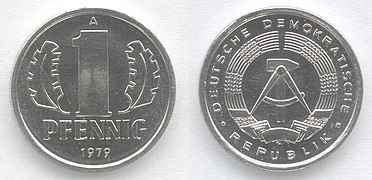penny
The pfennig (abbreviation Pf, Pf, Pfg or Dpf, symbol ₰) was a German currency unit that had existed as cash from Charlemagne until the introduction of the euro in 2002. He was over the centuries at the lowest Coinage -Nominal.

overview
Designations
The word pfennig (as a silver pfennig replacing the denarius or denarius ) can be traced back to the 8th century and was named Penning , Panni (n) g , Pfenni (n) c , Pfending u. a. called, e.g. B. in Prussia until 1873 Pfenning . The -ing - or -inc - suffix served alongside -ung , the formation of belongingness substantive u. Ä. And occurs in other coin denominations, for example in Schilling . The further origin is not clear, but an early borrowing from the Latin pondus ("weight", see pound ) is possible.
Related currencies
The pfennig was the “father” of a whole series of later coin denominations that became parts or multiples of the later actual penny: Groschen (“Großer [Pfennig]”, from Latin grossus “big, thick”), Angster (“Enger [Pfennig ] ”, From Latin angustus “ narrow, thin ”), Albus (“ white [pfennig] ”, from Latin albus “ white ”; initially in groschen size), Witten (“ white [pfennig] ”), black horse (“ raven ", So" Schwarzen [Pfennig] "), Stäbler , Heller (" Haller [Pfennig] "), Schwaren (" Schweren [Pfennig] ") u. a.
There were also “light pennies”, “good pennies” or “customs pennies”, which could be read directly from the embossing. Some pfennig gardens were given special names in the vernacular, such as the Erfurt "coffin pennies".
The pfennig was the model for the penni in Finland, for the fenig in Poland (1917 to 1918) and for the penn in Estonia (1919 to 1928) , which were in circulation until the introduction of euro cash . Even today, running in Bosnia-Herzegovina of fening order. The penny in Great Britain was created around the same time as the Carolingian denarius / pfennig.
The penny was also an old silver weight ( 1 / 256 Silver Weight Mark), comparable to the English pennyweight .
Term on tokens
Occasionally the term penny is also used on tokens that are not money in the strict sense. This could be, for example, “bread pennies”, which a city issued in times of need to subsidize the need for bread, or tokens within the truck system .
History of the penny
middle Ages
Charlemagne stipulated in the so-called Carolingian coin footer that 240 coins (equivalent to around 1.7 g of silver per coin) should be minted from one Carolingian pound of silver , which were named in Latin with the word denarius after the old Roman coin (see Sachsenpfennig - Coin foot ). The term later developed into the denier in France and the denaro in Italy. The Arabic word dinar (دينار) can also be traced back to the Latin word denarius . In Old High German, the denarius was named with the word pfennig ("phenninc") as early as the time of Charlemagne. It was later called Penning in northern German and Dutch-speaking areas and Penny in England . The term paenig for the Roman denarius appears for the first time in England around 765, when King Offa had denarii made of silver based on the Carolingian model . This explains the abbreviation "d" for d enarius, which was used in Great Britain for the "old" penny until 1971. The early pennies weighed around 1.3 g to 2 g, which tended to steadily decrease over the centuries. The frequent fluctuations in weight of the same pennies were partly due to production technology, with the higher-weight penny copies being subject to "constant private sorting", see Gresham's law . At that time, and even up to modern times, the total weight of a certain number of pennies of the same type had to be correct for larger payments, which tended to encourage different rates between smaller and larger coin denominations and then reached its absolute climax in the tipper and rocker era . For example, the terms “ shock penny” (= 60 pfennigs), “ shock groschen ” or “pound sterling” (= 240 d) provide information on these methods of payment with small coin denominations.
From the 8th to the 13th century the pfennig (or denarius) consisted of high-quality silver, in addition to other units only used as invoices, the sole currency denomination and had high purchasing power . This is why this era is also called the penny era in coinage . Pfennig halves, which were also known as oboles or scherfe , were minted only very rarely .
The Pfennig was around 1200, the largest and only German silver Kurantmünzen , except -Nominal of imported foreign gold and silver coins. Smaller monetary values were created by halving or quartering ( hack silver ), which was very easy to do with the one-sided thin hollow pennies or "strubben", which were then referred to as bracteates from the 17th century . The “change” that was often still needed to compensate for the price and quantity of buyers and sellers in the city markets consisted of small amounts of natural produce and goods that were included in the overall purchase process.
Around 1200, the various minters in Germany minted the pfennig very differently in terms of rough weight and fine silver weight ( shot and grain ) ( regional pfennig ), because the German kingship gave up the coin shelf or was not able to consistently enforce it as a uniform imperial footer. As a result, many regional pfennigs with different rates to each other were created over time. Because of the large amount of copper added, pfennig coins were given a black color; a distinction was then made between white pfennig ( Wißpennig , Albus , silver pfennig) and black pfennig (copper pfennig). A well-known example is the Haller Pfennig , which later became a Heller or Haller as an independent denomination in the later Imperial Coin Regulations and of which two pieces cost one pfennig until the 19th century. B. in Bavaria. Even with the early Hellern ("Händleinhellern") a noticeable copper alloy was used, so that the Heller soon became the first German "pure" copper coin.
The pennies of the Schinderling era, the black pennies, were minted from 1457 mainly in southern Germany, especially in Austria and Bavaria, with almost no silver. The so-called Böse Halser of this time consisted essentially of a copper-tin alloy. The Schinderlinge period ended with five pfennigs in 1460. For a long time, the black pennies undermined trust in the Austrian silver currency.
For the successful introduction of the silver groschen currency, which replaced the regional pfennig, enough change had to be available. The silver-rich Saxon dukes, for example, had Hohlpfennige and Hohlheller minted in their mints in Gotha and Langensalza according to a given coin order. The constant reduction in the silver content of the groschen, however, meant that new ordinances to reduce the silver content were required for the penny coinage, which was temporarily carried out by the cities (see the hollow pennies of the Thuringian cities ).
Price examples for the Saxon-Thuringian area
(after Krug :)
| 1324 | a chicken 2 pfennigs |
| a lamb belly 8 pfennigs | |
| before 1382 | a fattening pig 360 pfennigs |
| a young pig 180 pfennigs | |
| 1382 | a shock eggs 10 pennies |
| eight yards of linen cloth 54 pfennigs | |
| a port of butter 40 pfennigs | |
| a piece of fresh butter 3 pfennigs | |
| 1395 | six chickens 48 pfennigs |
The pfennigs are usually coins from the state main mint in Freiberg .
Modern times
17th and 18th centuries
At around the end of the 17th century, the pfennig declined to a pure copper vein coin. Some German minters minted copper and billon pennies at about the same time in the 18th century . However, from the middle of the 18th century the share of billon coins compared to pure copper pfennig coins tended to decrease, which was also carried over to 2 to 4 pfennig coins. The last silver-containing 1-pfennig coins with the denomination "Pfenig" were minted in Germany from 1808 to 1811 with the year 1808 in the Duchy of Saxony-Coburg-Saalfeld and are rare. The copper pennies were also not all of the same value. Bremen therefore called its pennies sware penninge (heavy pennies) for which the nominal name “Schwaren” prevailed.
19th and 20th centuries
Various small coin systems were in effect in the Prussian provinces until 1821. Only in the provinces of Brandenburg and Westphalia was the pfennig the smallest coin in terms of value. With the Prussian small coin reform of 1821, a uniform small coin system was introduced for all Prussian provinces. To distinguish it from the pfennigs before the reform, the new denomination was called "pfenning". One thaler no longer accounted for 288 pfennigs, but for 360 pfennings. This new value ratio was also named on the coat of arms: 360 EINEN THALER . Other states minted 1½ pfennig coins well into the 19th century, for example Saxony-Weimar-Eisenach.
In the southern German states (Baden, Württemberg, Bavaria with the Palatinate, Saxony and other smaller ones) the value of the Pfenni (n) g was fixed at 1/240 of a guilder since the coinage system from 1506 to 1871. (1 gulden at 60 kreuzers, the kreuzer at 4 pfennings, the pfenning at 2 hellers). The half pfennig (Heller) was the only coin of the guilder period to remain officially valid after the introduction of the Reich currency (because of the beer tax in Bavaria).
In some southern German states the term “ Heller ” was a synonym for the penny (for example in the city of Frankfurt and in the Duchy of Nassau). In Bavaria the Heller was considered half a penny.
The gold mark introduced as currency in the German Reich by the law of December 4, 1871 , received the pfennig with 1 mark = 100 pfennig as a decimal division under the second Reich Coin Act of July 9, 1873 . Until the introduction of the euro, this division was the smallest currency unit of the respective Mark currencies in Germany .
The last West German pfennig was copper-colored, embossed with a one on one side and oak leaves on the reverse and showed the year of issue and the code letter of the place of issue.
The 1-pfennig coin was made of steel coated on both sides with copper (approx. 0.03 mm thick), and had a diameter of 16.5 mm, a thickness of 1.38 mm and a weight of 2.00 G. The 2-pfennig coins were made of bronze up to the date of minting in 1968 , then also of copper-clad steel. The 5 and 10 pfennig coins were made of steel plated with brass .
The last pfennig coins of the GDR (as well as the coins denominated up to and including 2 marks) were all made of aluminum, with the exception of the 20-pfennig piece and the 50-pfennig piece that had been in circulation until 1956, which were made of brass or an aluminum - copper - alloy passed.
1 Pfennig of Goldmark
( German Empire )1 Reichspfennig of the Reichsmark
(Weimar Republic)1 Reichspfennig of the Reichsmark
( Third Reich )1 Pfennig of the German Mark
( Federal Republic of Germany )1 Pfennig der Mark
( German Democratic Republic )
Historical value relations
Here are some historical value relationships between the pfennig and other coin denominations, some of which were derived from the original pfennig:
- 1 helmet coin = 8 pfennigs = 12 hellers = 1 ⁄ 20 Rhenish guilders (1405–1411)
- 1 Jew's head groschen = 9 Pfennigs = 12 new Heller = 18 old Heller = 1 ⁄ 20 Rhenish guilders (1444–1451)
- 1 Horn dime = 9 Horn pennies = 18 Heller (1465-1482)
- 1 pointed groschen = 2 half sword groschen = 12 Pf (Saxon coinage system from 1482, see Mint Langensalza / Groschenzeit )
- 1 beard groschen = 12 pfennigs = 24 hellers (1492–1493)
- 1 farmer's groschen (minted between 1477 and 1490) = 12 Goslar or Hildesheim pfennigs
- 1 silver gulden = 1 Rhenish gold gulden = 252 Pf (according to the Saxon coin order of 1500 - see Saxon coin separation )
- 1 Reichsgulden at 21 Groschen (1584) = 1 Meißnischer Gulden = 252 Pf
- 1 interest groschen = 1 ⁄ 21 gulden = ⅓ Schreckenberger = 2 sword groschen = 12 pfennigs = 24 hellers
- 1 Reichstaler = 24 Groschen = 96 Dreier = 288 Pf (1571) - see Mint Dresden / The coins of the mint
- 1 convention or specialty thaler at 32 groschen = 384 pfennigs
- 1 (Prussian) thaler (from 1821) at 30 silver groschen = 360 Pf
- 1 (Saxon) thaler (from 1841) at 30 new groschen = 300 new pfennigs
- 1 (invoice) (Prussian) Reichstaler at 24 Groschen = 288 Pf
- 1 (association) guilder (20 Groschen) = 60 Kreuzer = 240 Pf
- 1 Nuremberg pound (477 g) silver for 1350 = 240 Pf
- 1 pound (silver) = 240 pfennigs by 1873.
- 1 pound GB = 20 shilling = 240 pence (d) until 1970, then 100 (new) pence (p)
- 1 Nuremberg Mark (238.6 g) silver around 1300 = 120 Pf
- 1 good groschen (good silver) groschen = 12 pfennigs
- 1 Schilling = 12 Pf (in the Middle Ages sometimes only 6 Pf)
- 1 Engl. Shilling (à 3 groat ) = 12 pence (see also Penny )
- 1 (Saxon) new groschen = 10 Pf
- 1 Mariengroschen = 8 Pf
- 1 Kreuzer = 4 Pf
- 1 Groten = 4 Pf = 5 flocks
- 1 Witten = 4 Pf
- 1 room = 4 Pf
- 1 Körtling ("short groschen") = approx. 4 to 8 Pf
- 1 (Bohemian / Silesian) Groeschel = 3 Pf
- 1 Russian grosch (copper groschen) = 2 copper kopecks = approx. 3.8 pfennigs
- 1 Polish grosz = 18 Polish pfennigs = approx. 1.9 pfennigs
- 1 Pf = 2 Heller , Scherf
- 1 new penny = 10 pfennigs (1841–1873)
- 1 (Reichs-, Renten-, Deutsche) Mark (of the German Central Bank, the GDR) = 100 Pf (from 1873)
The penny in idioms and songs
- “Pfennig” is still synonymous today for small amounts or taxes, cf. Coal penny .
- Lucky penny: Finding a penny means “lucky” in the vernacular .
- Pay / claim back on penny and penny ...
- Anyone who does not honor the penny is not worth the thaler.
- Penny fox ( curmudgeon )
- He doesn't have brains for two pfennigs. (He's a fool.)
- pfenniggut (Bavarian and Prussian dialect)
- Stiletto heel
- Schwänzelpfennig (regional: a small amount withheld)
Collector's value
A few penny coins have a high value among collectors; For example the 50-pfennig coin with the inscription " Bank deutscher Länder " and the year of issue 1950. The mint in Karlsruhe, coin letter "G", erroneously minted 30,000 fifty-pfennig pieces with the inscription "Bank Deutscher Länder" instead of "Federal Republic of Germany" in 1950 ". These mintings were only declared valid coins through a subsequent order, since at this point the coin sovereignty had already passed to the Federal Ministry of Finance. The high collector's value resulting from the rarity even led to forgeries, sometimes through combinations of halves of different coins that were ground on one side. On the back of the 50-pfennig piece, which was valid from 1949 to 2002, Gerda Johanna Werner is shown as an oak planter .
The 1-pfennig coins with the minting year 1948 are also in demand. Another rare pfennig piece is the 2-pfennig issue from the mint in Hamburg (J) in 1969 made of copper; this coin is not attracted to a magnet due to the material used.
With the abolition of the German mark and the introduction of the euro , the pfennig is no longer a valid money symbol either.
Penny mark
For “pfennig” the abbreviation “d” was used with priority, where “d” stands for the “ denarius ” (plural: “denarii”), a small Roman coin (cf. abbreviation “d” for → penny ). The pfennig symbol was used until after the Second World War . As the illustration on the right shows, it was a “d” written in the German Kurrent script with a downward curve. Until the 18th century, the latter was a common designation for abbreviations in German Kurrent script, such as the dot today . In the edition of handwritten originals or printed texts that use the penny mark, which is no longer in use today, in the German current script, it is often incorrectly transcribed with "ch" due to its similar form. The symbol corresponds to the German symbol for Deleatur . The penny sign is defined and coded as follows:
| character | Unicode position |
Unicode designation |
designation | HTML hexadecimal |
HTML decimal |
HTML named |
|---|---|---|---|---|---|---|
| ₰ | U + 20B0 | German penny sign | Penny mark | & # x20B0; | & # 8368; | - |
In current font versions the penny sign u. a. Included in the character set of Times New Roman ( ₰ ), Arial ( ₰ ), Courier New ( ₰ ), Malgun Gothic ( ₰ ), MS Mincho ( ₰ ) and Tahoma / Verdana ( ₰ ) under the currency symbols.
See also
- German currency history , German money , German coins
- Saxon coin history # Bracteatenzeit (time of the hollow pennies)
- Deutsche Mark , Mark of the GDR , Common Pfennig , Reichsmark , Fening of the convertible mark in Bosnia and Herzegovina
- Sachsenpfennig / Otto-Adelheid-Pfennig
- Red sigh , a six-pfennig piece from the Leipzig Mint
literature
- Article Pfennig in the German Legal Dictionary , Volume X, Columns 827–841.
- Article Pfennig in the German dictionary by Jacob and Wilhelm Grimm , Volume VII (paperback edition: Volume XIII), columns 1665–1668.
- Article Pfänning in the Swiss Idiotikon , Volume V, columns 1108–1120, then up to column 1134 all compositions with the basic word Pfänning .
- Daniel Schmutz, Benedikt Zäch: Pfennig. In: Historical Lexicon of Switzerland .
Web links
- German Bundesbank
- The coin find from Neudorf, City of Weismain (Landscape Museum Obermain)
- Unicode currency symbols (PDF; 88 kB)
- Whole page only with the penny symbol ₰! Website from Elmar Dünßer
- Penny mark ₰ in Unicode decodeunicode.org
Individual evidence
- ↑ The term pfenning served in this case to distinguish it from the pfennig from before 1821, when the taler was still 24 (good) groschen = 288 pfennig and not 30 silver groschen = 360 pfenning as from 1821 .
- ^ Friedrich Kluge: Etymological dictionary of the German language. Edited by Elmar Seebold, 25th edition, de Gruyter, Berlin / Boston 2011, s. v.
- ↑ The Erfurt “Sargpfennige” were allegedly minted from the silver-containing coffins of Catholic saints around 1525 during the Reformation period and some of them had the corresponding symbolism in their embossing (skull on crossed bones).
- ↑ Helmut Kahnt, Bernd Knorr: Old dimensions, coins and weights. A lexicon. Bibliographisches Institut, Leipzig 1986, licensed edition Mannheim / Vienna / Zurich 1987, ISBN 3-411-02148-9 , p. 394.
- ^ Helmut Friedl: The coins of the landgraves of Leuchtenberg and counts of neck. Regenstauf 2003, p. 12.
- ↑ Heinz Fengler, Gerd Gierow, Willy Unger: transpress lexicon numismatics. Berlin 1976, p. 343.
- ↑ Gerhard Krug: The Meissnisch-Saxon Groschen 1338-1500. Berlin 1974, p. 17.
- ^ Paul Arnold, Harald Küthmann, Dirk Steinhilber, Dieter Faßbender: Large German coin catalog from 1800 to today . 23rd edition. Battenberg Verlag, 2008, ISBN 978-3-86646-019-5 , pp. 399; No. 140 .
- ↑ Herbert Rittmann, On the development of the money system in the city of Bremen, in: Geldgeschichtliche Nachrichten , Issue 22, March 1971, pp. 61–66
- ↑ Treasures from your wallet: Which currency coins are the rarities of tomorrow? sammler.com
- ↑ Günter and Gerhard Schön: Small German coin catalog from 1871 to today. 34th edition. Battenberg, Munich 2004, ISBN 3-89441-554-1 , p. 135.
- ↑ ch as a penny symbol ( memento of December 30, 2009 in the Internet Archive ) in a field post letter from 1941.
- ^ Franz Hessel: Walking in Berlin. Edited by Moritz Reininghaus. Verlag für Berlin-Brandenburg, Berlin 2011, ISBN 978-3-942476-11-9 , pp. 164, 169, 176.
- ↑ The German Penny Sign in the Unicode website by Elmar Dünßer



















